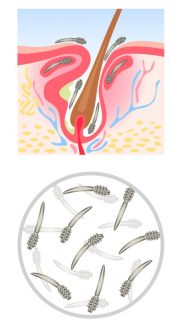Contents |
Demodex Mites
Blepharitis, a condition of inflammation of the eyelids, can be caused from several factors, including disruption of the tear film and dysfunction of glands in both upper and lower lids which contribute to dry eyes. This condition is quite common and can effect the outcome of surgical procedures such as removal of cataracts.
Another factor causing blepharitis that eyecare practitioners have become more aware of recently is infestation of the eyelash follicles by the tiny demodex mite. The mite lives at the base of the eyelash hair follicles and can sometimes also be found in the eyebrows and other facial areas. This particular type of blepharitis is sometimes called demodicosis.
It has been estimated that almost 85% of the population at age 60 have demodex mites, and that by age 70, that percentage increases to almost 100%. While this makes it important for seniors, it is also true that younger individuals can have demodex as well, and should be considered as a possible underlying cause of any cases of blepharitis.
Symptoms and Signs
The symptoms of demodex infestation are similar to those of blepharitis, including:
- Itching
- Burning
- Foreign body sensation
- Redness of the lid margins
- Swelling of the eyelids
In addition to these, the eyecare practitioner will see cylindrical-shaped crustiness around the bases of the eyelashes. If the lashes are sampled, the mites themselves may be visible under magnification with a light microscope.
Demodex mites have recently been associated with other skin disorders such as rosacea; treating rosacea patients for demodex mites not only makes their eyes more comfortable, but if the blepharitis is treated with both topical and systemic medications, most of the time the rosacea improves too.
Some patients with demodex don’t have symptoms, but an infestation can get out of control, in a similar way to how staph bacteria are usually present on most people’s skin, but don’t ordinarily cause infection under normal circumstances. Even a small infestation can be enough to cause trouble if the individual is sensitive to their presence.
Treatment
For demodex mites, the only really effective treatment is tea tree oil, which does kill the mites and interrupts their life cycle. Unfortunately, tea tree oil itself can be difficult to obtain and inconvenient to use for effective results; it also acts as an irritant itself, making management of demodex more difficult. Fortunately, a more user-friendly version of tea tree oil which consists of the active ingredient, melaleuca alternifolia, became available last year.
A treatment kit is available to eyecare practitioners to begin treatment in-office with an applicator, a single-use packet and a take-home package of single-use wipes. While tea tree oil is an eye irritant, the maker of the treatment kit stresses that there are no preservatives which could cause more symptoms such as allergic reactions. The commercially available treatment kit makes it much easier to treat this type of blepharitis, which is helpful, because those who are reacting to demodex will usually have frequent recurrences.
Some practitioners also advise a regimen of whole-body hygiene which includes a daily shampoo and soap, as mites can easily be transferred from one area to another. Weekly washing of bed linens and drying them in a hot dryer is an effective way to eliminate that possible source, as heat will kill the mites.
Some practitioners have expressed the opinion that patients with demodex infestation must be vigilant and consistent in treatment, as demodex are so widespread and re-infestation is so easy.
This significant source of blepharitis is now relatively easy to treat so those people who react to the mites no longer need to deal with tea tree oil but have another option to improve their comfort by eliminating the mites causing it.
Ask your eyecare practitioner about demodex mites and possible treatments.



